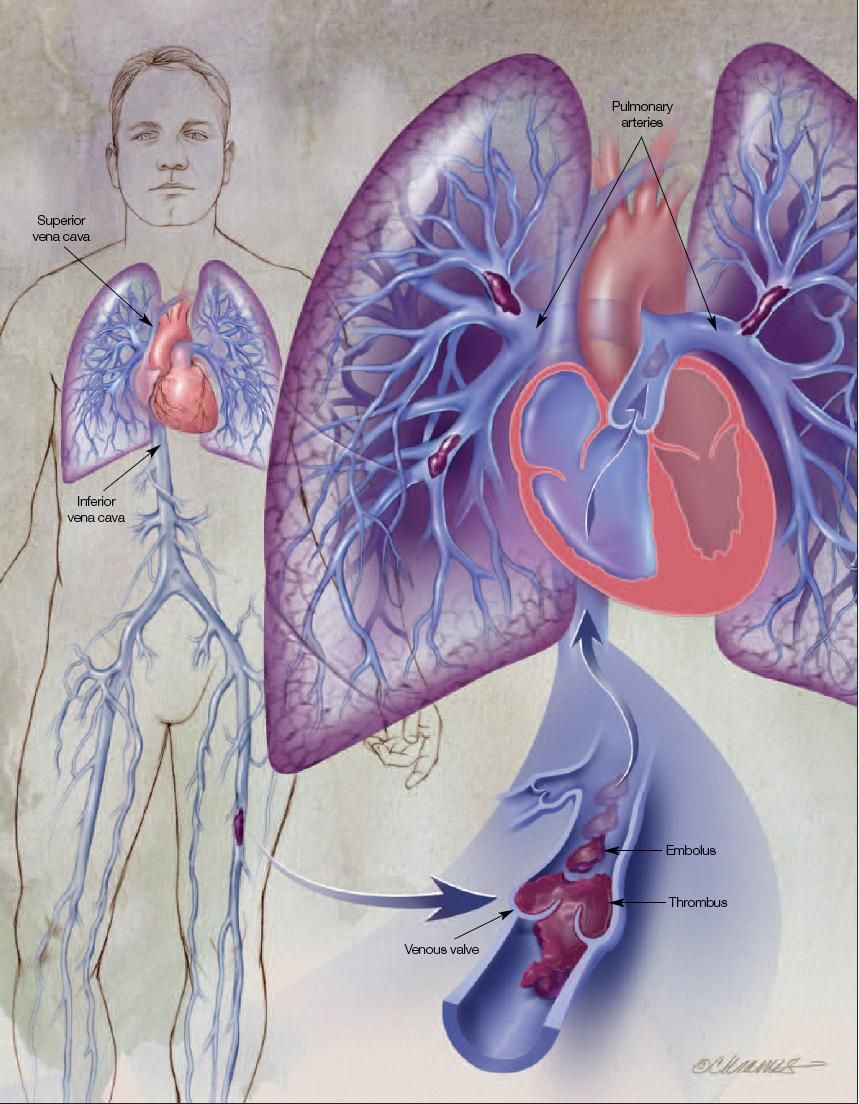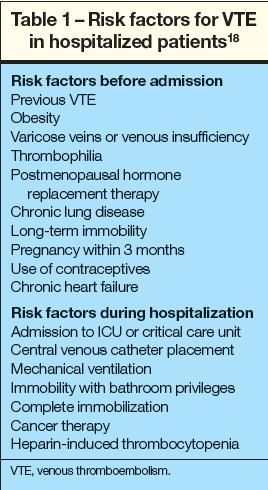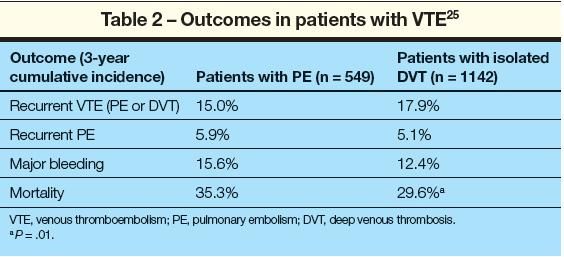Venous thromboembolism: Highlights of the latest reports
Venous thromboembolism (VTE) continues to be a common and potentially life-threatening problem, with an estimated incidence of at least 1 in 1000 persons per year.1,2 VTE includes both deep venous thrombosis (DVT) and the resultant pulmonary embolism (PE). PE occurs in as many as 50% of patients with proximal DVT.3
Venous thromboembolism (VTE) continues to be a common and potentially life-threatening problem, with an estimated incidence of at least 1 in 1000 persons per year.1,2 VTE includes both deep venous thrombosis (DVT) and the resultant pulmonary embolism (PE). PE occurs in as many as 50% of patients with proximal DVT.3
Up to 300,000 persons die of acute PE annually in the United States.1,4 PE accounts for 5% to 10% of deaths among hospitalized patients.5-9
This Clinical Update summarizes the results of recent studies on VTE-related topics, including risk factors, prophylaxis, diagnostic imaging, and treatment.
Risk factors
PE usually has its origin in DVT of the legs. DVT that is above the knee is associated with increased risk of PE (Figure).3

Figure – Pulmonary embolism usually has its origin in deep venous thrombosis of the legs. In the scenario shown here, a thrombus formed in a venous valve pocket above the knee. The embolus traveled to the right side of the heart and then reached the lungs. (Adapted from Tapson VF. N Engl J Med. 2008.3)
A number of risk factors for VTE have been identified, such as major surgery, reduced mobility, cancer, and advanced age.3,4 Nursing home residency is an important risk factor, 10,11 and VTE-related mortality has been shown to be higher in nursing home residents than in community-dwelling persons.12
•Risk in nursing home residents: Leibson and colleagues13 conducted a population-based study of nursing home residents in Minnesota. A multivariate analysis indicated that the risk of VTE was increased among those who had returned from a hospital (odds ratio[OR], 6.29); needed assistance with mobility-related activities, such as grooming (OR, 5.10); and required assistance with behavior (OR, 10.26). Interestingly, there was an inverse association between VTE risk and the number of years since first nursing home admission (OR, 0.64), which is the opposite of what would be expected on the basis of long-term immobility.
In addition, the authors compared their VTE cases with an incident cohort of nursing home residents in whom VTE was diagnosed. The incidence of VTE per 1000 person-years was higher in the cohort than in the study cases. Moreover, 62% of the episodes in the cohort were identified as PE, compared with 21% to 24% in the study cases.
The authors concluded that accurate identification of VTE among nursing home residents requires that these persons be followed up across institutional settings, and they suggested that the transition from acute to long-term care represents an important opportunity for preventing VTE. They also suggested that the need for assistance with mobility-related activities may represent a subset of nursing home residents for whom the risk of VTE is particularly significant.
•Minor injuries and VTE risk: Although major injury is a well-known risk factor for VTE, a recent study in the Netherlands suggests that certain minor injuries-specifically, minor leg injuries-also are associated with increased risk. VanStralan and coworkers14 conducted a population-based case-control study that included 2471 patients with VTE (either DVT or PE) and 3534 controls. The risk of VTE was higher in persons who had had a minor leg injury in the preceding 3 months (adjusted OR, 5.1). The risk was highest in the 4 weeks after the injury and decreased sharply thereafter. Injuries involving other sites were not associated with increased risk.
The study also found that the risk of VTE was 50-fold higher in patients with leg injuries who were factor V Leiden mutation carriers. The authors say that minor leg injuries may be important contributors to VTE, considering how common such injuries are. They suggest that short-term prophylaxis in patients with leg injuries might prevent many cases of VTE.
Prophylaxis
The risk of VTE can be reduced substantially by the use of appropriate prophylaxis, and guidelines for prophylaxis are available.6,15 However, several studies have demonstrated that prophylaxis is considerably underused.16-19 For example, a significant proportion of hospitalized patients who are at risk for VTE are not receiving the recommended prophylaxis, according to a multinational cross-sectional survey conducted by Cohen and associates.18
The Epidemiologic International Day for the Evaluation of Patients at Risk for Venous Throm-boembolism in the Acute Hospital Care Setting (ENDORSE) study was designed to evaluate the prevalence of VTE risk in the acute care setting and to assess the extent to which patients are receiving VTE prophylaxis as recommended by the American College of Chest Physicians. More than 68,000 patients were enrolled; 55% were medical patients at least 40 years of age, and 45% were surgical patients at least 18 years of age.
About 52% of patients were considered to be at risk for VTE- 64.4% of surgical patients and 41.5% of medical patients (Table 1). Only 50.2% of the at-risk patients received the recommended prophylaxis (58.5% of at-risk surgical patients and 39.5% of at-risk medical patients).18

Another study, conducted by Jois-Bilowich and associates,19 found that VTE prophylaxis is underused in patients with heart failure. The investigators analyzed data from the Acute Decompensated Heart Failure National Registry. Of 155,073 entries evaluated, 71,376 were eligible for VTE prophylaxis. Of these, only 31% received prophylaxis.19
Diagnostic imaging
In recent years, CT pulmonary angiography (CTPA) has been introduced as a noninvasive alternative to ventilation/perfusion (V /Q) lung scanning for the assessment of PE.20 Anderson and coworkers21 conducted a randomized controlled trial to determine whether CTPA is an acceptable alternative to V/Q scanning as an initial imaging study in the evaluation of PE. The study included 1417 patients in whom acute PE was considered likely on the basis of clinical probability and d-dimer test results.
Patients were randomly assigned to undergo V/Q scanning or CTPA. Those in whom PE was excluded did not receive antithrombotic therapy and were monitored for the development of symptomatic PE or proximal DVT for up to 3 months.
The results indicated that CTPA was as good as V/Q scanning in ruling out PE. In addition, the use of CTPA helped identify significantly more cases of PE than did V/Q scanning (19.2% vs 14.2%).
The authors acknowledged that V/Q scanning should still have a role in the assessment of PE, partly because it involves less radiation exposure and has fewer contraindications than CTPA. They suggest that CTPA be considered for patients who have a high clinical probability for PE and nondiagnostic V/Q findings.
Treatment
Unless contraindicated, anticoagulation with low-molecular-weightheparin (LMWH), fondaparinux, or standard unfractionated heparin is warranted in patients with acute PE.3 LMWH and fondaparinux have some advantages over unfractionated heparin, such as greater bioavailability, more predictable dosing, subcutaneous delivery, less need for monitoring, and less risk of heparin-induced thrombocytopenia (HIT).3 These agents have been demonstrated to be effective in the management of symptomatic PE and DVT.22-24
Spencer and associates25 reported findings that suggest the need to improve anticoagulation strategies. They studied 1691 hospitalized and nonhospitalized patients who had a documented episode of acute VTE; 32.5% had PE, and the remainder had isolated DVT. Most of the patients were given unfractionated heparin, LMWH, and/or warfarin. Those with PE were more likely to be initially treated with unfractionated heparin alone or in combination with LMWH, to have an inferior vena cava filter placed during hospitalization, or to receive warfarin initially.
At 1 month, 1 year, and 3 years' follow-up, patients with PE and patients with isolated DVT did not differ significantly with respect to recurrence of PE or overall VTE or the incidence of major bleeding, although the mortality rate was higher in those who initially had PE (Table 2). However, the rates of VTE recurrence and major bleeding were relatively high. The authors say their findings underscore the need to improve anticoagulation strategies for long-term use in the community setting.26

Heparin-induced thrombocytopenia
HIT is a life-threatening immune response to heparin that is associated with significant thromboembolic complications. Management includes the discontinuation of heparin and initiation of treatment with a direct thrombin inhibitor, such as argatroban or lepirudin. Warfarin therapy should not be initiated until platelet count recovery has occurred.
• Argatroban for HIT in women: Women are at increased risk for HIT and have a worse prognosis than men. Jang and colleagues26 retrospectively studied 42 women and 50 men who received argatroban for the treatment of HIT. The dosage was adjusted to achieve an activated partial thromboplastin time (aPTT) of 1.5 to 3 times baseline. Argatroban was typically maintained at 1.0 to 1.1 μg/kg/min for about 6 days.
The investigators found that men and women did not differ significantly with respect to aPTT during treatment, time to therapeutic aPTT, or platelet count recovery. They also did not differ in the incidence of major bleeding or the composite end point of death, amputation, or new thrombosis within 37 days of initiation of therapy. The authors concluded that argatroban is safe and effective in the management of HIT in women, and that the dosing requirements and clinical outcomes are comparable to those in men.26
•Fondaparinux for acute HIT: Lobo and associates27 conducted a pilot study that included 7 patients with acute HIT who received fondaparinux and a historical control group of 10 patients who were treated with a direct thrombin inhibitor. Six of the 7 patients who received fondaparinux and 8 of the 10 who received a direct thrombin inhibitor were transitioned to warfarin after platelet count recovery occurred.
All of the patients who received fondaparinux had a complete platelet count recovery, and none had any new thromboembolic event or major bleeding by week 4. One patient underwent limb amputation. In the control group, platelet count recovery occurred in 8 of 10 patients. There were no new thromboembolic events or major bleeding, but limb gangrene occurred in 4 patients. The authors acknowledge that the cases of limb gangrene may have been the result of delayed recognition of HIT or inappropriate early initiation of warfarin in the control group.27
•Argatroban after CABG: Recent evidence suggests that reduced dosages of argatroban may be necessary after cardiovascular surgery. To investigate this issue, Hoffman and associates28 retrospectively studied 39 patients who had undergone coronary artery bypass graft(CABG) surgery and received argatroban for HIT.
The median argatroban dosage was 0.5 µg/kg/min initially and 0.6 µg/kg/min during therapy, and the median duration of therapy was 5.3 days. Within about 16 hours of treatment, 85% of patients achieved consecutive therapeutic aPTTs. Thrombosis developed in 1 patient, finger amputation occurred in 1 patient, and significant bleeding occurred in 4. Seven patients died, with 5 of the deaths occurring after the cessation of argatroban.
The authors concluded that reduced initial dosages of argatroban produce rapid and adequate anticoagulation in patients with HIT after CABG surgery.28
References:
REFERENCES
1.
Silverstein MD, Heit JA, Mohr DN, et al. Trends in the incidence of deep vein thrombosis and pulmonary embolism: a 25-year population-based study.
Arch Intern Med.
1998;158:585-593.
2.
Oger E. Incidence of venous thromboembolism: a community-based study in Western France. EPI-GETBP Study Group. Groupe d'Etude de la Thrombose de Bretagne Occidentale.
Thromb Haemost.
2000;83:657-660.
3.
Tapson VF. Acute pulmonary embolism.
N Engl J Med.
2008;358:1037-1052.
4.
Heit JA, Cohen AT, Anderson FA, VTE Impact Assessment Study Group. Estimated annual number of incident and recurrent, non-fatal and fatal venous thromboembolism (VTE) events in the U.S. [ASH annual meeting abstracts].
Blood.
2005;106:267a.
5.
Dismuke SE, Wagner EH. Pulmonary embolism as a cause of death. The changing mortality in hospitalized patients. JAMA. 1986;255:2039-2042.
6.
Geerts WH, Pineo GF, Heit JA, et al. Prevention of venous thromboembolism. The Seventh ACCP Conference on Antithrombotic and Thrombolytic Therapy. Chest. 2004;126:338S-400S.
7.
Sandler DA, Martin JF. Autopsy proven pulmonary embolism in hospital patients: are we detecting enough deep vein thrombosis?
J R Soc Med.
1989;82:203-205.
8.
Lindblad B, Sternby NH, Bergqvist D. Incidence of venous thromboembolism verified by necropsy over 30 years.
BMJ.
1991;302:709-711.
9.
Alikhan R, Peters F, Wilmott R, Cohen AT. Fatal pulmonary embolism in hospitalised patients: a necropsy review.
J Clin Pathol.
2004;57:1254-1257.
10.
Heit JA, Silverstein MD, Mohr DN, et al. Risk factors for deep vein thrombosis and pulmonary embolism: a population-based casecontrol study.
Arch Intern Med.
2000;160:809-815.
11.
Heit JA, O'Fallon WM, Petterson TM, et al. Relative impact of risk factors for deep vein thrombosis and pulmonary embolism: a population- based study.
Arch Intern Med.
2002;162:1245-1248.
12.
Heit JA, Silverstein MD, Mohr DN, et al. Predictors of survival after deep vein thrombosis and pulmonary embolism: a populationbased, cohort study.
Arch Intern Med.
1999;159:445-453.
13.
Leibson CL, Petterson TM, Bailey KR, et al. Risk factors for venous thromboembolism in nursing home residents.
Mayo Clin Proc.
2008;83:151-157.
14.
van Stralen KJ, Rosendaal FR, Doggen CJ. Minor injuries as a risk factor for venous thrombosis.
Arch Intern Med.
2008;168:21-26.
15.
Nicolaides AN, Fareed J, Kakkar AK, et al. Prevention and treatment of venous thromboembolism: International Consensus Statement (guidelines according to scientific evidence).
Int Angiol.
2006;25:101-161.
16.
Tapson VF, Decousus H, Pini M, et al. Venous thromboembolism prophylaxis in acutely ill hospitalized medical patients: findings from the International Medical Prevention Registry on Venous Thromboembolism.
Chest.
2007;132:936-945.
17.
Yu HT, Dylan ML, Lin J, Dubois RW. Hospitals' compliance with prophylaxis guidelines for venous thromboembolism.
Am J Health Syst Pharm.
2007;64:69-76.
18.
Cohen AT, Tapson VF, Bergmann JF, et al. Venous thromboembolism risk and prophylaxis in the acute hospital care setting (ENDORSE study): a multinational cross-sectional study.
Lancet.
2008;371:387-394.
19.
Jois-Bilowich P, Michota F, Bartholomew JR, et al. Venous thromboembolism prophylaxis in hospitalized heart failure patients.
J Card Fail.
2008;14:127-132.
20.
Strashun AM. A reduced role of V./Q. scintigraphy in the diagnosis of acute pulmonary embolism.
J Nucl Med.
2007;48:1405-1407.
21.
Anderson DR, Kahn SR, Rodger MA, et al. Computed tomographic pulmonary angiography vs ventilation-perfusion lung scanning in patients with suspected pulmonary embolism.
JAMA.
2007;298:2743-2753.
22.
Merli G, Spiro TE, Olsson CG, et al. Subcutaneous enoxaparin once or twice daily compared with intravenous unfractionated heparin for treatment of venous thromboembolic disease.
Ann Intern Med.
2001;134:191-202.
23.
Buller HR, Agnelli G, Hull RD, et al. Antithrombotic therapy for venous thromboembolic disease: the Seventh ACCP Conference on Antithrombotic and Thrombolytic Therapy [published correction appears in Chest. 2005;27:416].
Chest.
2004;126(suppl):401S-428S.
24.
Buller HR, Davidson BL, Decousus H, et al. Fondaparinux or enoxaparin for the initial treatment of symptomatic deep venous thrombosis: a randomized trial.
Ann Intern Med.
2004;140:867-873.
25.
Spencer FA, Gore JM, Lessard D, et al. Patient outcomes after deep vein thrombosis and pulmonary embolism.
Arch Intern Med.
2008;168:425-430.
26.
Jang IK, Baron SJ, Hursting MJ, Anglade E. Argatroban therapy in women with heparininduced thrombocytopenia.
J Womens Health (Larchmt).
2007;16:895-901.
27.
Lobo B, Finch C, Howard A, Minhas S. Fondaparinux for the treatment of patients with acute heparin-induced thrombocytopenia.
Thromb Haemost.
2008;99:208-214.
28.
Hoffman WD, Czyz Y, McCollum SA, Hursting MJ. Reduced argatroban doses after coronary artery bypass graft surgery.
Ann Pharmacother.
2008;42:309-316.